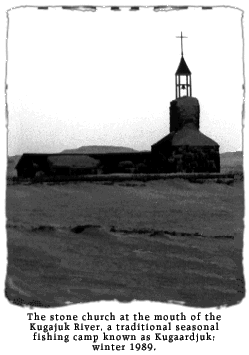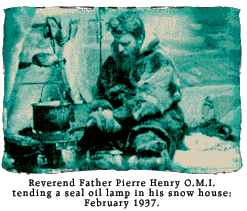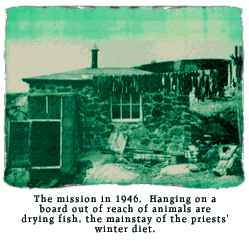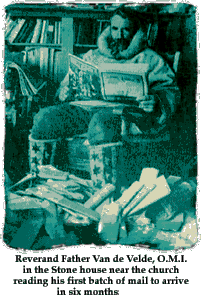|
Northern Vignettes
Arctic Harpoons
Beechey Island
Crystal II
Deline/Fort Franklin
Fort Hope
Fox Moth
Kellet's Storehouse
Naujan
Old Fort Providence
Old Fort Reliance
Stone Church
Thule Village
Yellowknife
Fort Journal
 Built in 1941 by Reverend Father Pierre Henry (1904-1979) a missionary Oblate of Mary Immaculate this church is a landmark in Arvilikjuak, "the big place with bowhead whales". The walls were built with local stones and clay hauled by dogteam, which also provided transportation for the roofing paper and beams from Repulse Bay, 320 kilometres away. The steeple was completed in 1952 by Reverend Father Frans Van de Velde O.M.I, and housed the bell donated by American benefactors, to fill the empty belfry. Unfortunately a subsequent fire reduced this bell to a molten mass. The cross atop the belfry was donated in 1942 by Corporal (later Superintendent) Henry Larsen of the Royal Canadian Mounted Police, a friend of Father Henry. The church which now stands at Kugaardjuk the
mouth of the Kugajuk River, was not the first raised there. Sharing their way of life Father Henry brought
the Roman Catholic faith to the people of Arvilikjuak. Father Henry remained in Pelly Bay until 1945 and Father Van de Velde until 1965. Henry Larsen visited the the mission on his historic traverse of the Northwest Passage in the St. Roch and recalled the celebration on Mass in 1942.
These fragile remains are protected from disturbance by Northwest Territories Archaeological Sites Regulations. |
 Shortly
after his arrival in the spring of 1935 Father Henry, called Kayualuk
because of his red beard, built the first stone and clay house chapel.
It measured only ten by twenty feet: driftwood beams supported a
canvas roof waterproofed with seal oil and ashes. An interior ceiling
of seal skins and a stove made from a gasoline drum, fuelled with
seal oil and bones, served to warm this building during the moderate
seasons; a snow house proved more comfortable during inclement weather.
Shortly
after his arrival in the spring of 1935 Father Henry, called Kayualuk
because of his red beard, built the first stone and clay house chapel.
It measured only ten by twenty feet: driftwood beams supported a
canvas roof waterproofed with seal oil and ashes. An interior ceiling
of seal skins and a stove made from a gasoline drum, fuelled with
seal oil and bones, served to warm this building during the moderate
seasons; a snow house proved more comfortable during inclement weather. In
1938 Father Van de Velde joined him in his ministry of the parish
which eventually extended to Somerset and King William Island. Unlike
earlier Europeans, John Rae (Hudson's Bay Company) Sir John Ross
(Royal Navy) and Knud Rasmussen (Fifth Thule Expedition) who had
journeyed through the territory, the priests lived, travelled and
worked with the people of Arvilikjuak for many years. With the mission
as its nucleus, sedentary settlement came to the traditional summer
fishing camp in the late 1950s.
In
1938 Father Van de Velde joined him in his ministry of the parish
which eventually extended to Somerset and King William Island. Unlike
earlier Europeans, John Rae (Hudson's Bay Company) Sir John Ross
(Royal Navy) and Knud Rasmussen (Fifth Thule Expedition) who had
journeyed through the territory, the priests lived, travelled and
worked with the people of Arvilikjuak for many years. With the mission
as its nucleus, sedentary settlement came to the traditional summer
fishing camp in the late 1950s.  "On Easter morning we joined in the service attended by
about eighty Eskimos of all ages. The little stone building was
packed , and only the very old could sit down on the floor close
to the priest in front of his little improvised altar. On one side
of it the Father had a great pile of frozen fish that was thawing
slowly. On the other was a big blubber lamp with a large pot of
meat which was simmering ready for the feast which was to follow
the service. The father had taught these people hymns and prayers,
and the service was conducted in the Eskimo language... During the
Mass the Priest would take a couple of seconds off and with a Dominus
give a stir in the meat pot, while with a vobiscum he would adjust
the flame on the blubber lamp... It was all so very special..."
"On Easter morning we joined in the service attended by
about eighty Eskimos of all ages. The little stone building was
packed , and only the very old could sit down on the floor close
to the priest in front of his little improvised altar. On one side
of it the Father had a great pile of frozen fish that was thawing
slowly. On the other was a big blubber lamp with a large pot of
meat which was simmering ready for the feast which was to follow
the service. The father had taught these people hymns and prayers,
and the service was conducted in the Eskimo language... During the
Mass the Priest would take a couple of seconds off and with a Dominus
give a stir in the meat pot, while with a vobiscum he would adjust
the flame on the blubber lamp... It was all so very special..."